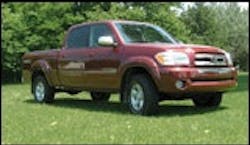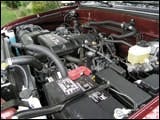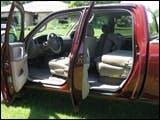Tundra Double Cab: Not Big Enough?
Toyota Motor Sales, U.S.A., has achieved lofty status among American automobile buyers, and its compact and now mid-size Tacoma pickups have proved wildly popular in some areas of the country. Customers testify to their vehicles' great build quality and long life, resale values are high, and the company leads the way in hybrid power-train technology. To the mainstream press, Toyota can do no wrong.
Then why hasn't it scored high with its full-size pickup trucks? Because size matters, and Toyota trucks haven't had enough of it. The T100, its first try, was mid-sized and lacked a V-8 engine. The Tundra is bigger, but still falls a little small. It's about 7/8 the size of pickups from America's Big Three manufacturers. Maybe, too, buyers don't perceive Toyota as a serious maker of big pickups; and let's face it, the competition fields some pretty nice trucks.
By year's end Toyota will begin producing a larger Tundra, one that's actually a bit bigger than current 1/2-ton full-size competitors — Ford's F-150 and 1500 series models from General Motors and Dodge (not to mention the Titan from Nissan). But is the current Tundra really too small? I actually like smaller pickups for my own use and appreciate the trim feeling of the current Tundra Access Cab, which is Toyota's answer to Ford's Super Cab, General Motors' Extended Cab, and Dodge's no-longer-offered Club Cab.
But there's no feeling of trimness with the long, four-door Double Cab. It feels every bit as big as a Ford F-150 Super Crew, for example, and is as much work to fit into a parking lot slot. If "big" is what American pickup buyers want, the Double Cab has it.
If "buy American" is a criterion among customers, even in these days of a World Economy, most might not know that the Tundra has always been assembled in the States, in Princeton, Ind., and now at a new plant in San Antonio, Texas. Most of its components are made in America, as well.
Commercial customers have not been high on Toyota's sales list, but it does offer the Tundra Regular Cab, a usually bare-bones truck with the base V-6 engine and an 8-foot-long bed. Toyota had one of these, with tool boxes and ready to work, on display at the National Truck Equipment Association's trade show in Atlanta this year, and NTEA members will give one away in a sweepstakes later this year.
But Toyota says the Regular Cab is now out of production and its Detroit public-relations office didn't have one for me to drive. So I had to make do with the Double Cab you see here, and it wasn't bad duty. I used it for six days and drove it from Detroit to Milwaukee, then home to Westerville, Ohio, where I live.
To be sure, the Double Cab is primarily a personal or family vehicle, but it could double as a tradesman's or landscaper's truck. The latter would find the back seat useful for carrying workers to a job and towing a trailer that's not too heavy. There's room and seating inside for five big people, and the center console has convenient storage compartments and cup holders. Towing capacity is 6,700 pounds for the four-wheel-drive model.
The bed is 6 feet long, or 8 feet and beyond when the tailgate's folded down. There's a bit over 4 feet of space between the wheel wells, so you can easily haul the proverbial 4×8-foot sheet of plywood. This truck had a plastic liner and it narrows the width to almost exactly 4 feet between the wells. That means a 4-foot-wide piece of wallboard would be nicked unless you rest it on wood blocks or wedge 2×4s onto side supports along the two walls, then stack the wallboard on them.
Plastic liners protect a pickup bed's steel panels, and are slippery. That's fine if you've got to grab stuff and slide it out, like cardboard boxes or hay bales. But you have to tie down smooth objects to keep them from moving around, and dirt and moisture can work their way between the liner and the steel bed. So a spray-in liner or a rubber floor mat might be better ideas.
The TRD off-road suspension makes the truck sit high off the ground, aiding ground clearance for undercarriage parts. That's great if you get into rough terrain a lot, but few folks do. And meanwhile, you and your passengers have to climb into a cab whose floor sits two feet off the pavement. That's not the highest in the business, but it's a bother for shorter people. Running boards or nerf bars would help, and they're readily available from dealers or aftermarket suppliers.
During almost 800 miles of driving, I used the four-wheel-drive system just once, to turn around by backing onto a sandy construction site. I really wouldn't have needed it, but I didn't want to spin any wheels and, besides, it demonstrated the ease with which the push-button controls work. The transfer case under the floor engages and disengages with just a hint of a click. Later I engaged it again on the lawn in front of my house; to get to 4W-Lo I had to first engage 4W-Hi, which I'd have known if I'd looked it up in the owner's manual. The manual is very complete, with 520 pages of information. It ranges from the usual recommendations for oil and tire pressures to changing bulbs in the head- and tail lights (not always an intuitive exercise and something seldom covered in such manuals).
The rear seats fold two ways and you can stow a lot of stuff back there. With SR5 trim, all seats, front and rear, were covered in a plain-looking but probably durable grey cloth, and were firmly padded. The bucket-type seats in front were not posh, but were very supportive. I spent the better part of three days on midwestern highways and never felt sore.
While driving, I found all gauges and switches easy to see and use, or did once I got accustomed to an odd mix of import- and American-style controls. For instance, cruise control is operated from a small stalk to the lower right of the steering wheel and windshield wipers are run from a longer stalk just above it; but the parking brake is set and released by a foot pedal near the far-left wall.
The 4.7-liter (287-cubic-inch) i-Force V-8 had plenty of power and I was always able to more than keep up with traffic. Then again, I have a light foot that comes from driving heavy trucks. Most folks want their pickups to accelerate like cars, and they think that they need a big-inch engine to do it. Toyota will accommodate them with a 5.7-liter V-8 in the upcoming Tundra, whether or not that turns out to be wise in this age of hefty gasoline prices.
As you'd expect with a 4×4, the ride was stiff but smooth if the pavement was. On broken concrete the ride was jouncy, though not enough to loosen any tooth fillings. Brakes were adequate, but I had to really push the pedal for short stops and the pads seemed sticky as the truck approached a standstill. This, along with the space and work needed to maneuver the truck in tight quarters, makes me wonder why folks would like it, or any full-size crew-cab pickup, for personal use. Those who do are quick to praise the high-up view of traffic and the general feeling of safety and power.
There's a price to be paid in fuel economy, however. I got 15 to 17 miles per gallon in city and highway driving. But if there are things to be hauled, especially dirty or outsized objects that commercial users or suburban homeowners sometimes must contend with, there's nothing like a pickup to tote the load. For me, the Double Cab is more than big enough; Toyota fans who think it's just right have six or so months to go out and grab a new one.





